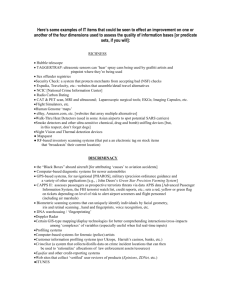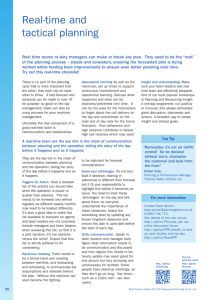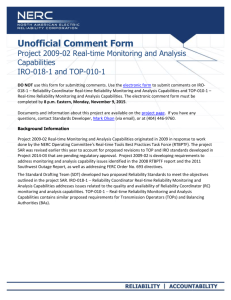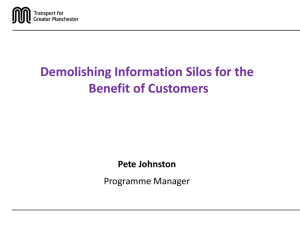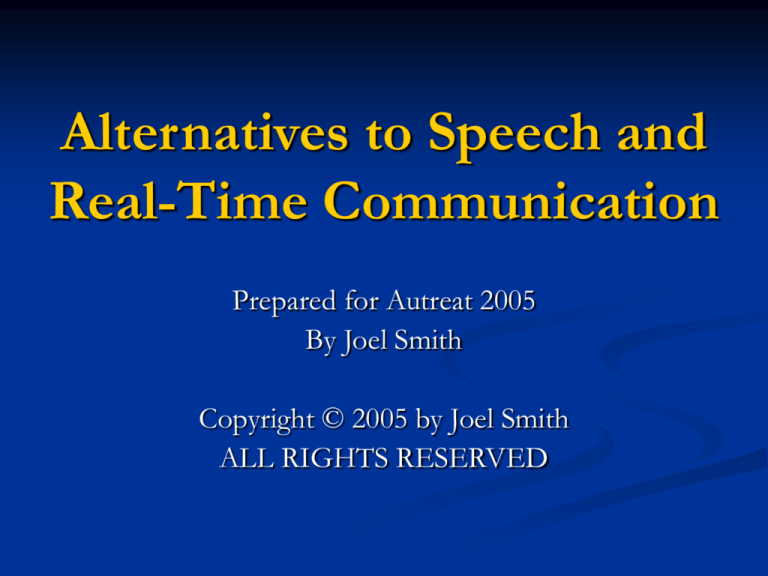
Alternatives to Speech and
Real-Time Communication
Prepared for Autreat 2005
By Joel Smith
Copyright © 2005 by Joel Smith
ALL RIGHTS RESERVED
What We Will Talk About
Why would you want to use something other
then real-time speech?
What options are there for common situations
requiring real-time speech?
How do you handle prejudice and ignorance?
MOST IMPORTANT POINT
It is okay to not
communicate
“normally”
PART I
WHY WOULD YOU WANT AN
ALTERATIVE TO REAL-TIME
SPEECH?
What is “Real-Time Speech”?
“Real-Time” – requiring composing and expressing a
thought quickly in response to some external action
“Speech” – using your biological voice
Real-Time Speech is anything that combines the realtime aspect defined above with a biological voice
This presentation will focus on communication
techniques other then real-time speech. These include
methods that are real-time but not speech, methods
that are speech but not real-time, and methods that are
neither speech or real-time
Why Real-Time Speech is
Difficult
It requires a good working memory to
remember parts of sentences/paragraphs that
you have already spoken, as they are gone once
voiced
It requires an understanding of common
English (in most of the countries represented
here) language syntax, grammar, and vocabulary
It requires ability to quickly formulate thoughts
and responses
Other Reasons Not to Talk
Physically painful
Interrupts your own thoughts when you hear
your own voice
Any other physical or neurological problem that
makes it hard to talk
Can’t concentrate on reaction to words while
concentrating on speaking
Hard to ask for help or express emotional
content
Why I don’t always use real-time
speech
Talking hurts my throat
It depletes my energy reserves quickly
When somewhat overloaded, I cannot access speech at
all
It is often not possible for me to use speech to ask for
help or tell an authority figure they are wrong
I cannot use real-time speech to talk about my own
strong emotions
But I can talk – so people don’t realize I’m leaving a lot
of things unspoken
Using Other Forms of
Communication, I can…
Tell a friend, “Thank you for your friendship. It means
a lot to me.”
Tell a dentist, “The tooth you worked on last week is
rubbing against the tooth above it, and is starting to
give me a headache”
Ask a shopkeeper, “What are the advantages of this
product over the cheaper version?”
On the phone with computer support, “Hey, I bought
the extended warrantee to avoid exactly this kind of
problem. You are under a contractual obligation to fix
this machine!”
PART II
COMMUNICATION OPTIONS
You don’t have to give up real-time
speech!
If you find real-time speech is helpful to you,
continue to speak during those times it is useful!
It’s not “faking” to communicate typically
sometimes and atypically other times
It’s okay to combine typical and atypical
communication techniques
Two Types of Communication
Non-linguistic: Picture or symbol based
Examples
PECS
Symbol boards (where symbols express an entire thought)
Gestures
Linguistic: Language based
Examples:
Sign language
Writing
Speech
Some complex symbolic systems
Which Type of Communication?
BOTH!
Linguistic communication provides the highest degree
of self-direction in our society
Non-linguistic communication can often be used to
supplement language and engage in simple exchanges
(why type “Yes, I want that” when a nod will do?)
However…some individuals have difficulty learning or
using linguistic communication. Non-linguistic
communication can allow them to take an active role in
their own life and should be respected as a valid form
of communication.
Non-Linguistic Communication
Can be used by people unable to access any form of
language (whether temporarily unable or permanently
unable)
Some systems can be used with partners who don’t
share a common language with the speaker (for
instance, grunting and smiling have fairly universal
meanings)
Vocabulary quickly becomes too large to be feasible
Communication partners often have to guess as to
possible subjects of conversation
Communication topics may be limited by vocabulary
Gestures
Commonly understood meaning within a culture
Not sign language!
Used by most people to add “depth” to
communication
Can be used by themselves, especially in quick
encounters with predefined interaction scripts
(store counters, airline agents, walking past a
friend)
Sometimes need to be exaggerated when used as
stand-alone methods of communication
Vocalizations
Sounds other then normal linguistic speech
Can be used in place of “yes” and “no”
Can convey excitement, sadness, anger, and
other emotions
Almost all autistic people do this already, even
young children and people with no language
ability!
Object Exchange
An object (or representation of the object) is
handed to a communication partner
Often used to teach the concept that one thing
can represent another thing, which is a
fundamental abstract concept of language
An empty cup handed to a caregiver might
indicate that you are thirsty; a bus pass might
indicate that you want to go out
Music Communication
Good for communicating emotions
Requires communication partner to understand
what you are trying to do
Entire songs or parts of songs are played or
sung
Among the slowest of communication methods
Very limited “vocabulary”
Art Communication
Pictures, sculptures, and other forms of art used
to express a thought
Can express thoughts that are otherwise very
difficult to express
Not always recognized as communication
Interpretations of art can differ
Example Communication Board
Example Communication Board
Communication Boards
Most commonly used as a teaching tool to show the
value of language
Some boards can be large with hundreds of symbols.
However, most contain a couple dozen or less
Good if you know what the “script” will look like and
that communication won’t deviate from that script
Non-linguistic symbol boards may not be useful if you
cannot foresee the direction a conversation will take
Can be made very cheaply, and used in situations other
techniques may not be able to be used (intimate
settings, the pool, oxygen tent, etc)
Tantrums, Meltdowns, Violence,
etc.
Behavior is often a form of communication
Autistics rarely do something for no reason!
Often other forms of communication were tried
but not listened to, prior to meltdown
Its important to help a person find other forms
of communication that are socially acceptable,
but some behavior is unavoidable and a result of
disability - thus it requires accommodation
Linguistic Communication
Very flexible – in most languages, nearly any
idea, opinion, request, or demand can be
expressed
Typically have moderate sized vocabularies
Requires relatively little “guessing” on part of
the communication partner, so unexpected
utterances are fairly easy
Requires ability to cognitively process language
Requires communication partners to also have
literacy in the language
Pre-Composed Notes – Good &
Bad
Requires fairly good written language skills
Allows nearly unlimited composition time
Allows use of spelling and grammar checking
tools, proofreading by others, etc.
Can often hide traits that might be seen as
negative (no eye contact, unusual speech
“accent”, need to stim, etc.)
Can help mitigate “working memory” problems
Pre-Composed Notes - Examples
To get through security at a friend’s apartment:
I do not speak. I am visiting <friend’s name>’s
apartment, <apt. number>. I have a key and am in the
book. My name is Joel Smith.
Pre-Composed Notes - Examples
To buy a meal:
I would like two cheeseburgers and medium fries. I
want a large Sprite to drink.
Pre-Composed Notes - Examples
To get back to my car at Denver airport:
M3
E-Mail, Letters
People with good written communication look
“good” in this medium
Many business transactions can take place online or through mail-order (banking, shopping,
personal correspondence, etc)
For autistics with advanced literacy, this can be a
medium of empowerment
Internet or Mail Ordering
Instant Messaging (IM)
Requires a computer and internet connection
Good for autistics who have problems with
speech
Eliminates non-verbal signals from the
communication
Little feed-back while other party is composing
message, causing “out of order” messages
Sign Language
Requires ability to learn a language
Limited number of communication partners
May be difficult for people with motor control
issues
Relies somewhat on facial expressions, eye
contact, etc.
May be good if you have severe CAPD but little
problem with language and real-time
communication
Interactive Handwriting
Requires literacy of both sender and receiver
Does not solve “real-time” issues
Very cheap! Can be used when more expensive
solutions cannot, such as in wet or high crime
environments
Easy to use, requires little training if handwriting
is legible and literacy is achieved
Portable Text-to-Speech
Synthesizers
Require good language skills
Easier to use with good typing speed and spelling ability
Good for interacting with unfamiliar people where the
message can be complex
Often only practical means of communicating to a
group interactive without someone else’s assistance
Can be used over the telephone
Very expensive ($2,500-$16,000 USD new), although
used units can be found significantly cheaper (Ebay –
anywhere from $15 on up, depending on age and
condition of device)
Speech Synthesizers - Problems
Often too quiet in noisy environments (restaurants, break times
with large groups, train stations, etc)
Often too loud in other environments (libraries, church) – can be
considered disruptive by others
Can be frustrating – spelling and speech synthesizer limitations
often cause mispronunciations
Unusable in some environments (moisture, high crime, at dark or
in direct sunlight)
English (American dialect) male voices are easiest to understand
Foreign person and place names are almost always
mispronounced
If you are bilingual, you may need a multilingual device
TTY (TDD)
Designed as a way of using the telephone by deaf people
Great for calling large businesses in countries with disability
accommodation laws (avoid long hold times, communicate
clearly)
Can be used with relay services where an operator translates
between you’re your TTY and a receiver who uses a different
mode of communication (including a receiver who speaks
normally and doesn’t use a TTY)
Internet relay is also an option for many
People with communication disabilities may qualify for a free
TTY from their government
Requires understanding some basic TTY etiquette
TTY - Problems
Requires good language skills
Slower then normal phone conversation
No “interrupting” each other
Internet relay (and sometimes non-internet relay) is
associated with fraud
Hard to use with public phones and wireless phones
International calls may require a device that can speak
at two different rates (US and some other nations use
45 baud while most nations use 50 baud)
Facilitated Communication (FC)
FC involves the physical support of a person
communicating, often supporting the wrists, arms, or
shoulder
There is real communication taking place today because
of FC
There is also influenced communication (“puppet on a
string”) taking place in the name of FC
FC appears to deal with Parkinson-like motor planning
issues that have been found in autistics
Independent communication is always a long range
goal, but its important to consider realities and allow
other communication in the short term
What I Use
Lightwriter and Link as portable text-to-speech
synthesizers
Handwriting
Gestures
“Vocalizations”
Speech
Text-to-speech computer program
TTY
Email & Instant Messaging
Pre-composed written messages
Familiar friends and family
PART III
PREJUDICE & IGNORANCE
Common Reaction
(in most of US & Canada)
People assume you are deaf
If you walk and otherwise outwardly appear
normal, people don’t seem to make assumptions
about intelligence
If a technological device is used, people are very
curious
No “active” discrimination
Other then curiosity, most people do not make a
big deal of it and just interact fairly normally
Less Common Reaction
(in most of US and Canada)
You are less intelligent then average (especially if you
use other forms of assistive technology or you “look”
disabled)
You are disruptive (speech devices in particular are
often louder then desired)
People speak to you in “child” voices and phrases
Some people think you’re an “asshole” when you are
now able to speak things I couldn’t speak before
In workplace, written forms of communication can
sometimes be considered more likely to cause
arguments – “We need more facetime among
employees”
Professional Attitudes
People with moderate sized vocabularies and good
word pronunciation, and who can use language, are
assumed to not be a group that would benefit with
alternatives to real-time speech
Once a person develops any amount of speech, it’s
assumed that speech should become the main form of
communication
There is an assumption that IQ, “functioning level” or
other bogus measures can be used to figure out who
would benefit from alternatives to real-time speech
Often address alternatives to speech but not the realtime component – either or both may be problematic
Autistic Attitudes
Sometimes will misapply the terms “selective” and
“elective” mutism (my pet peeve – you know less about
my speech problems then I do, so don’t diagnose me!)
Most autistics don’t have a problem with others using
alternative means of communication
May be significantly more curious than most people
People with CAPD may have a hard time understanding
synthetic voices
Many autistics who communicate with real-time speech
have a hard time with “turn taking”
Other Difficulties
Group conversation is very difficult as it is very hard without
using a natural voice to indicate a desire to participate – and
speech devices don’t allow the precise timing that this requires
Most linguistic methods are best suited for seated positions –
some are very difficult to use while walking or standing
Employers will initially see someone who does not use real-time
speech as someone who is less able to do the job
All alternatives to speech, except perhaps sign language, are
extremely slow compared to speech
All alternatives to real-time communication and some
alternatives to speech are prone to misunderstandings (especially
emotional content)
Personal Attitudes
“I am faking this”
“I’m doing this for attention”
“I’m not disabled enough to need this”
“Speech is better”
MOST IMPORTANT POINT
It is okay to not
communicate
“normally”
QUESTIONS
???



